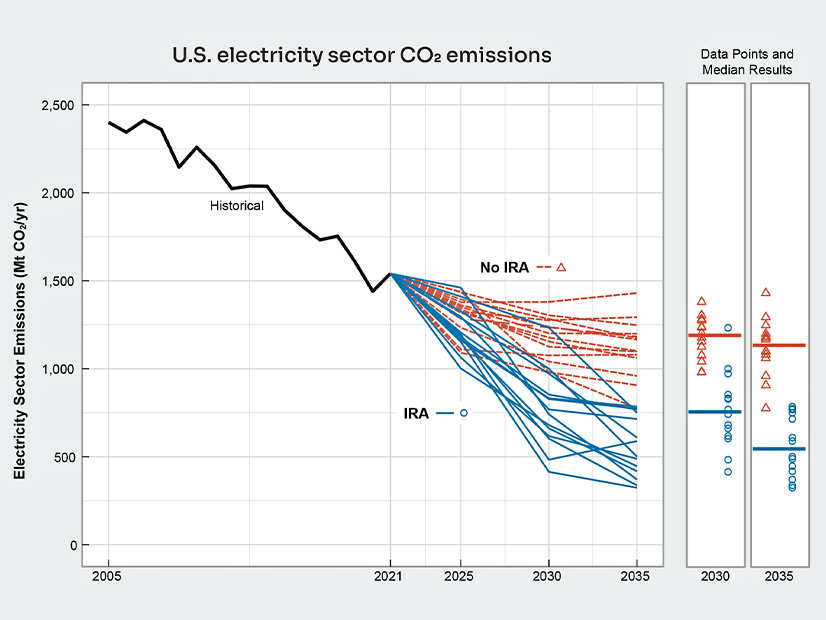
A new EPA report projects significant emissions reductions from the electric power sector by 2030 as provisions of the IRA take hold.
The report — “Electricity Sector Emissions Impacts of the Inflation Reduction Act” — is imprecise because of the range of constraints that could increase or decrease over the next seven years, including policy, technology and availability.
But even the low-end models suggest a large decrease in greenhouse gas output: The electric sector could see a reduction of 49 to 83% from 2005 levels by 2030, or even as high as 91% under advanced-technology scenarios. The report projects a 40 to 68% decrease would occur without the IRA.
EPA was mandated to produce the report as part of the Low Emissions Electricity Program of the IRA.
The report models carbon dioxide emissions reductions with and without the provisions of the IRA. Both scenarios incorporate state and federal policies finalized before Biden signed the IRA into law in August 2022. Neither scenario reflects rules and regulations now being developed or finalized.
The report incorporates data from 10 multisector models (changes in generation and use of electricity) and four electric-sector models (changes only in generation) created by EPA, the Department of Energy and the National Renewable Energy Laboratory.
All but one of the models show the bulk of the reductions will result from construction of new wind and solar facilities assisted by IRA incentives; infrastructure buildout assisted by the Infrastructure Investment and Jobs Act; and increased energy storage. The other model relies heavily on carbon capture and storage to reduce emissions.
All the models are based on increased use of low- and zero-emissions technologies and decreased use of high-emission coal- and gas-fired generation.
That is at the heart of the IRA: Its provisions support clean electrical generation, encourage electrification of end uses and promote energy efficiency.
Under the various models, emissions are expected to be 11 to 25% lower in 2030 than in 2005 in the transportation sector, 49 to 63% lower in the buildings sector and 11 to 43% lower in the industrial sector. Economywide, emissions are projected to drop 35 to 43% by 2030.
Transportation is the laggard because of the sheer number of internal combustion vehicles that must be replaced by EVs, and because some modes of transportation may not see wholesale changes attributable to the IRA.
EPA noted that future analyses of the IRA’s effects would benefit from completion of processes still in motion — final tax credit guidance on clean hydrogen, for example, or further improvement in technology. Complementary federal, state and local policies are expected to evolve as well.
Some IRA tax credits extend beyond 2030, as well. And the technology development and deployment expected to result from the IRA will not be complete by 2030.
In a news release Tuesday, EPA called the IRA the most significant policy action on clean energy and climate change ever, and EPA Administrator Michael Regan hailed the impact projected in the report.
“The Inflation Reduction Act is transforming energy production and consumption in dramatic ways, paving the way towards a clean energy future,” he said. “This report shows robust evidence that America’s clean energy transformation is driving significant reductions in CO2 emissions, putting us on a clear path to achieve President Biden’s bold climate goals.”
EPA is part of the executive branch of federal government, and the IRA is a signature achievement of the executive, President Joe Biden.
He faces a tough fight for re-election and the IRA faces a potentially rocky road if he loses or if the Republicans who opposed the package of spending and policy measures succeed in winning control of both chambers of Congress.


